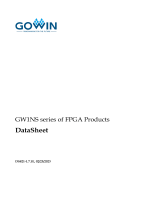
2 Guideline on HDL Coding
2.1 General Requirements of HDL Coding
long data path into several levels of logic and breaking it up over multiple
clock cycles. Pipeline structure is an effective way to improve data path
speed; however, special care must be taken due to the additional clock
cycle latency of data path.
2.1.3 Comparing If-Then-Else and Case Statements
The if-then-else statement generates priority-encoded logic, whereas
the case statement implements balanced logic, and it is recommended that
if statement be nested less than 5 levels.
If-then-else statements can contain a set of different expressions, but
a case statement can contain only one expression. If-then-else statements
and case statements are equivalent if the conditions are mutually
exclusive.
2.1.4 Avoiding Unintentional Latches
FPGA users should avoid using latches. The synthesis tools can build
them out with feedback loops, which will increase the design area and
result in performance degradation and problems with static timing analysis
by introducing combinatorial feedback loops.
The Synthesis tool infers latches from incomplete conditional
expressions; for example, an if-then-else statement without an else clause
or a case statement without a default clause. To avoid unintentional latches,
specify all conditions explicitly.
If the client uses the case statement and does not care about the
output value of the default condition, /* synthesis full_case*/ constraint can
be added to avoid the generation of the latch.
2.1.5 Global Reset and Local Reset
A global set/reset (GSR) network is built into Gowin devices. There is a
direct connection to the core logic. It can be used as an
asynchronous/synchronous set or asynchronous/synchronous reset. The
registers in CFU and I/O can be individually configured to use the GSR.
The global reset resource provides a convenient mechanism by which
design components can be reset without using any general routing
resources. Local reset usually has smaller fan-out. It is recommended to
use common routing as a reset signal.
2.1.6 Clock Enable
Gating clocks is not encouraged in FPGA designs because it can
cause timing issues, such as unexpected clock skews. The CLS structure
in Gowin devices contains dedicated clock enable signals. You can use
clock enable as a better alternative to achieve the same functions without
worrying about timing issues. You should take the following into
considerations when using the clock enable function of Gowin devices.
1. Clock enable is only supported by flip-flops, not latches.
2. Each CLS in the same CFU shares one clock enable signal.
3. All flip-flops have a positive clock enable input.



























